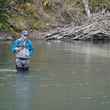In 2013, U.S. Department of Fish and Wildlife reported that cooperation from Montana ranchers was helping the last of the state's native grayling survive. According to Montana conservation groups and residents, such reports by the department are false or unsupported by evidence. These groups have filed a formal notice of intent to sue which claims that the U.S. Fish and Wildlife have failed to protect the last of the lower 48's native grayling, which survive only in Montana's Big Hole River, a few small lakes and a small population reintroduced in the Ruby River.
The lawsuit is planned by The Center for Biological Diversity, Western Watersheds Project, Butte resident Pat Munday and former Montana fishing guide George Wuerthner.
The U.S. Fish and Wildlife Service has applauded the participation of Montana ranchers in its voluntary program to reduce water withdrawals from the Big Hole, which it has described as a significant success and one that has led to the beginnings of recovery in the grayling population. And while the program's critics have also applauded the ranchers action, they say it simply isn't enough to protect a truly endangered species such as the grayling.
“Montana's unique grayling are on the brink of extinction and should have been protected under the Endangered Species Act,” said Noah Greenwald, endangered species director at the Center. “Efforts by the state and some ranchers to improve habitat for the grayling are commendable, but just have not been enough to reverse the grayling's perilous decline.”
The issue, claims the lawsuit, is the voluntary nature of the U.S. Fish and Wildlife Service's efforts to protect the struggling grayling populations.
“There is no way to ensure the survival of the grayling without leaving enough water in the river and protecting the stream and streambanks from habitat degradation,” said Travis Bruner, executive director of Western Watersheds Project. "The Fish and Wildlife Service’s reliance on voluntary reductions in water use offers cold comfort in the face of near extinction of a species."
According to the groups, grayling populations are not showing signs of recovery, making the U.S. Fish and Wildlife's recent decision to deny grayling additional protections indefensible.
“It is incredibly sad that we must sue the Fish & Wildlife Service to follow the law and protect grayling,” added Pat Munday, a college professor who authored a popular book about the Big Hole River. “The agency claims that grayling numbers are increasing, but provides no credible, statistically valid evidence for this claim. In fact, when you examine the data, it appears that there is a consistent, long-term decline in the grayling population.”
Grayling, which require cold, clean water to survive, currently exist in only 4% of their historic range in the contiguous United States.






























Comments